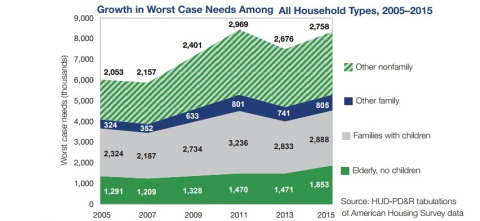Despite continued signs of a strengthening national economy, HUD's reported this month that severe housing problems are on the rise. In 2015, 8.30 million households had worst case needs, up from 7.72 million in 2013. These households are defined as very low-income renters who do not receive government housing assistance and who paid more than one-half of their income for rent, lived in severely inadequate conditions, or both. High rents in proportion to renter incomes remain dominant among households with worst case needs, leaving these renters with substantial, unmet need for affordable housing.

Contributing most to the increase in worst case needs between 2013 and 2015 was a notable shift from homeownership to renting. The magnitude of this sustained post-recession trend, along with other demographic factors, increased the number of very low-income renters and thereby played a major role in growing worst case needs between 2013 and 2015. Modest gains in household incomes were met with rising rents, shrinking the supply of affordable rental housing in an increasingly competitive market. Even with the supply of more expensive units growing, higher-income renters occupy a growing share—43 percent—of the most affordable units. Only 62 affordable units are available per 100 very low-income renters.
